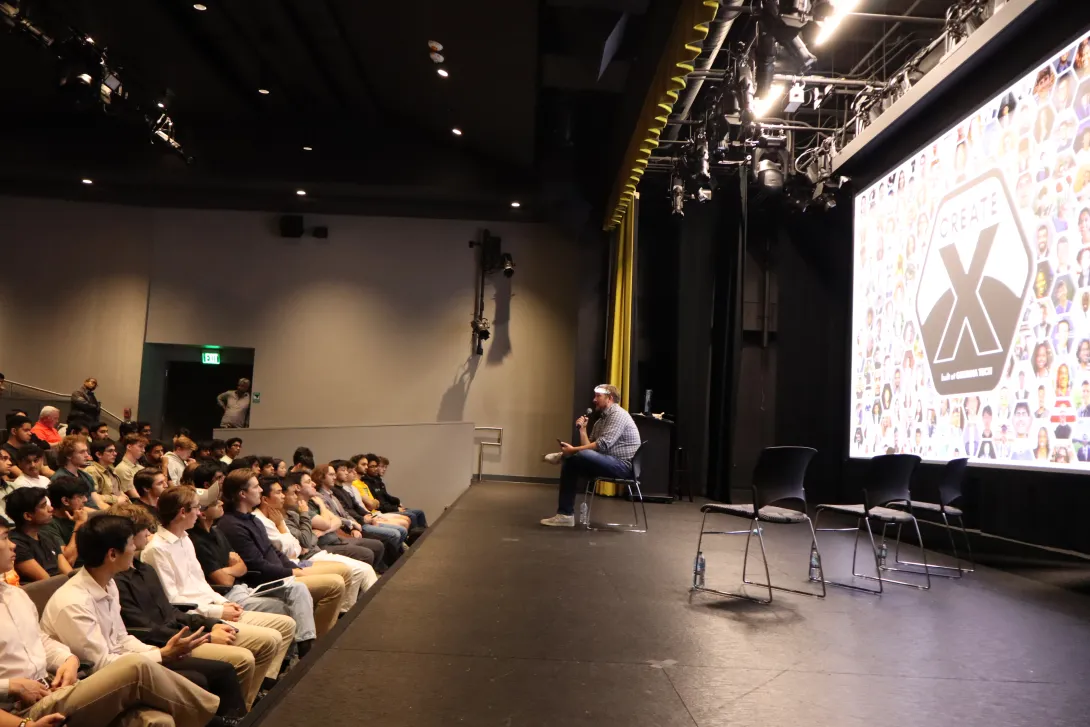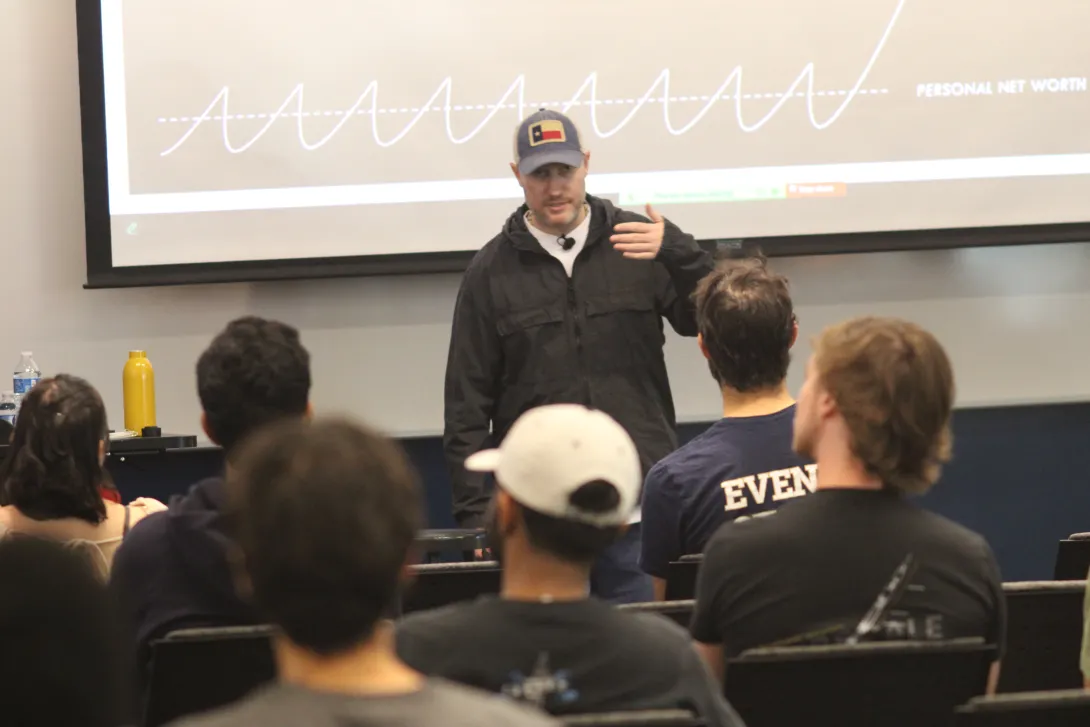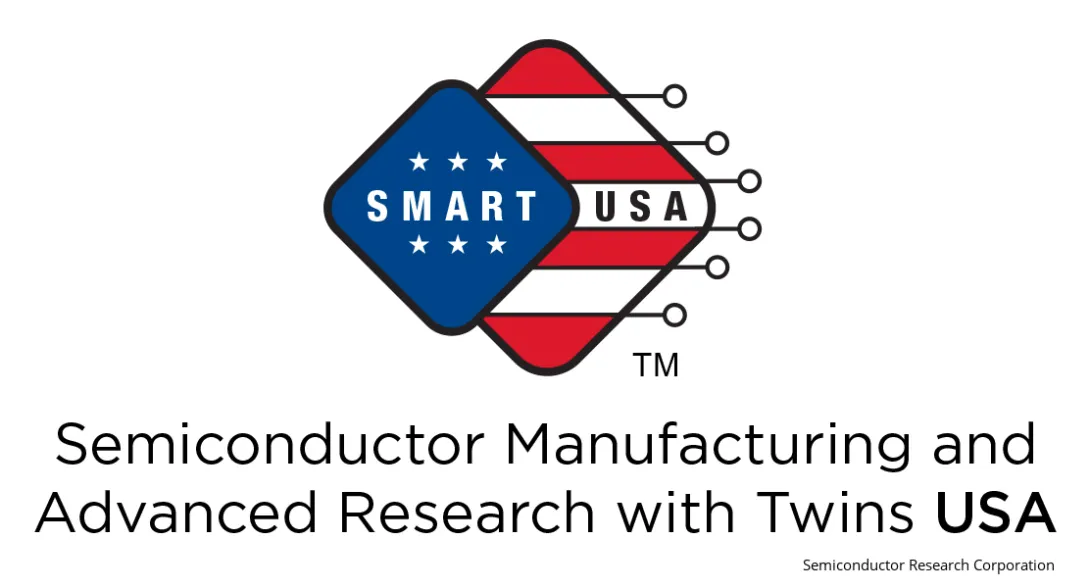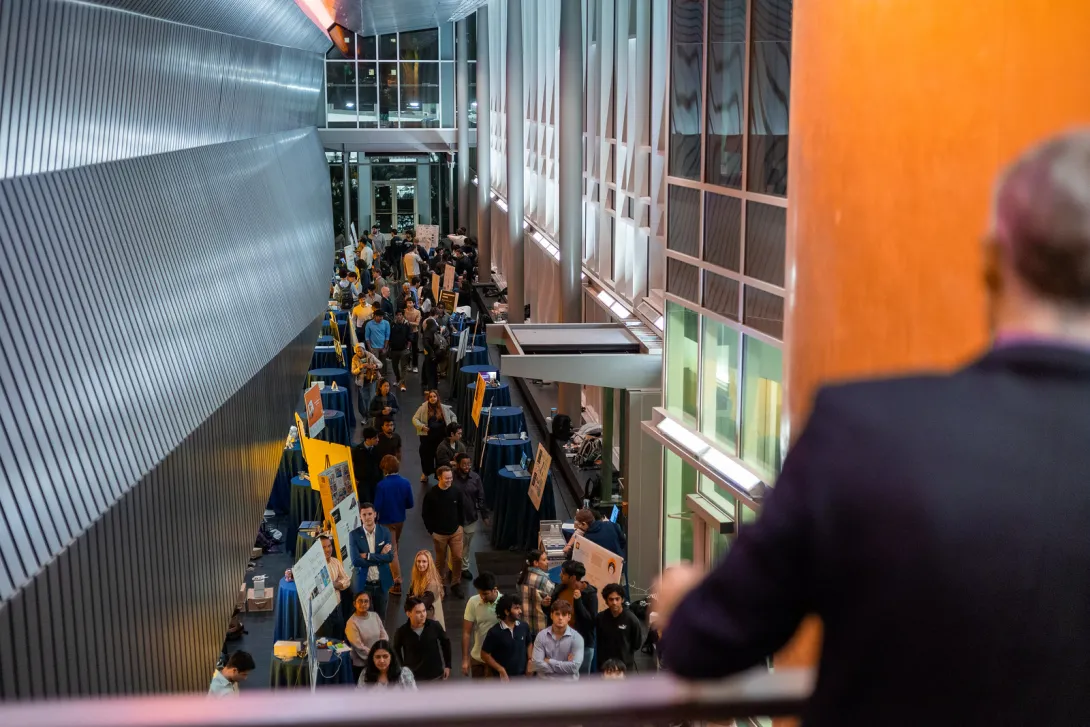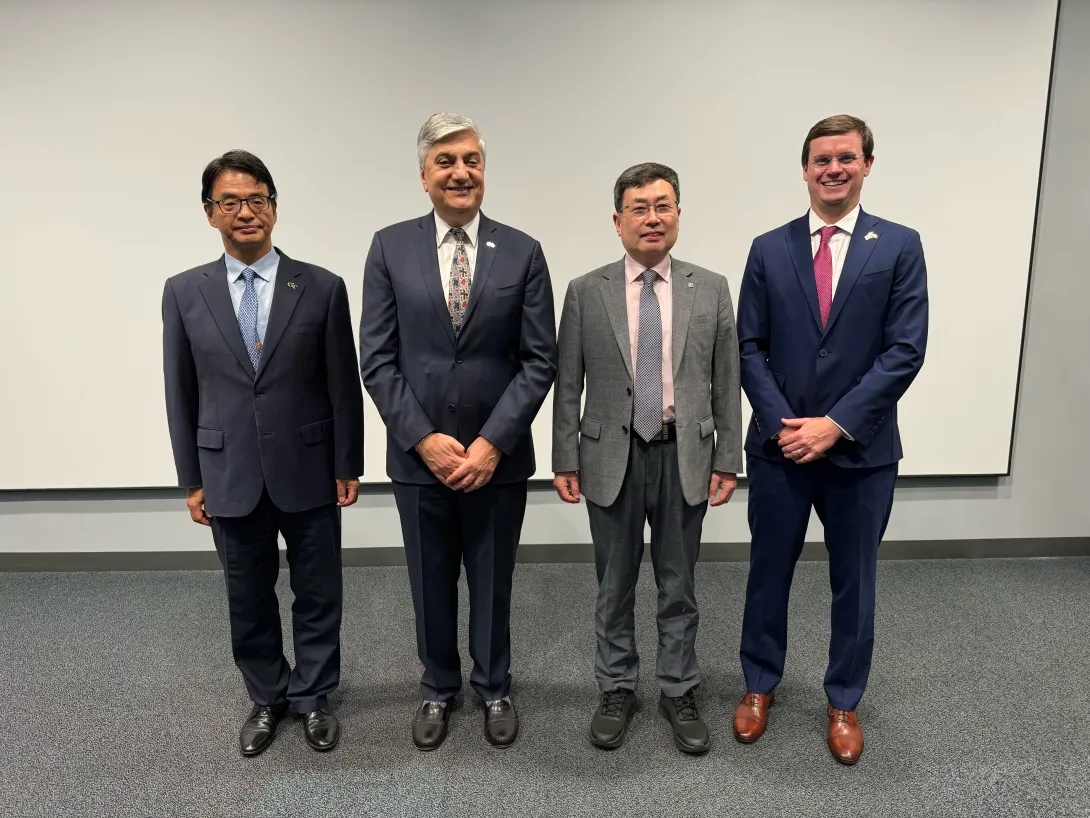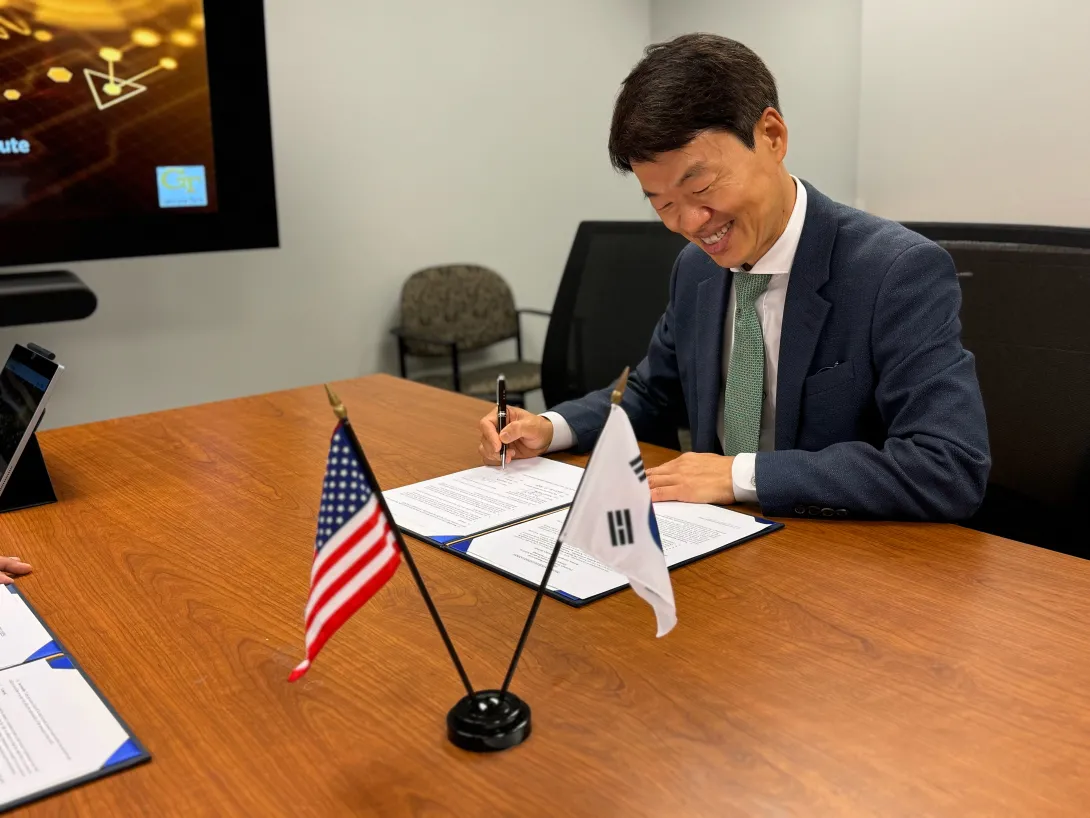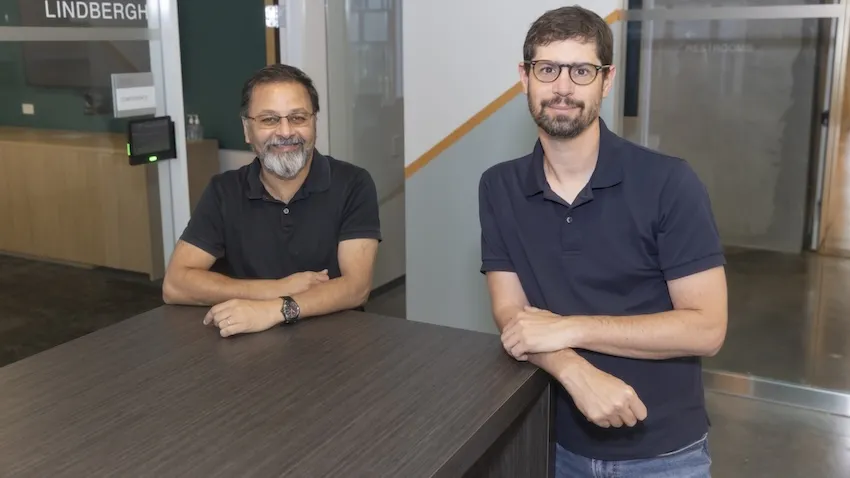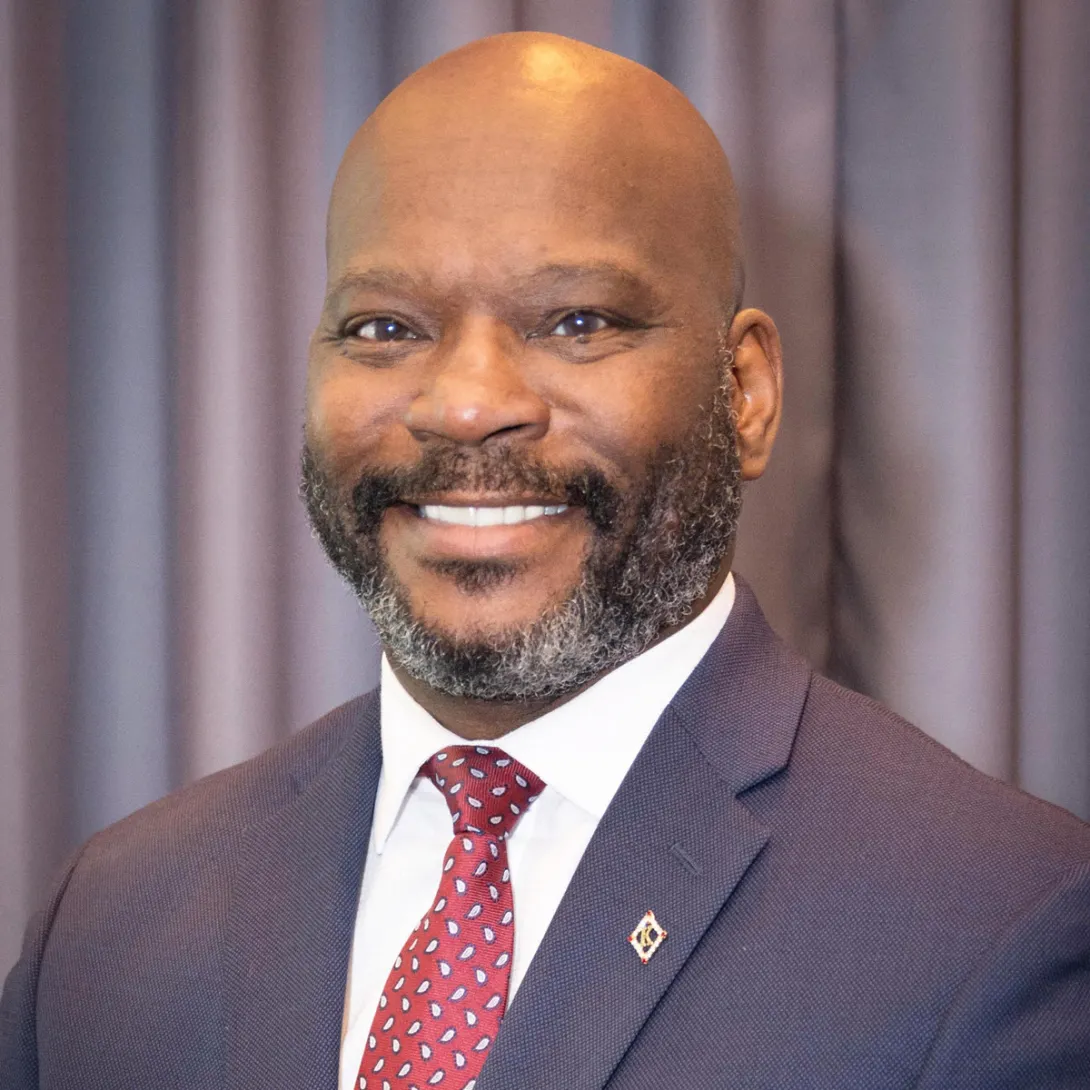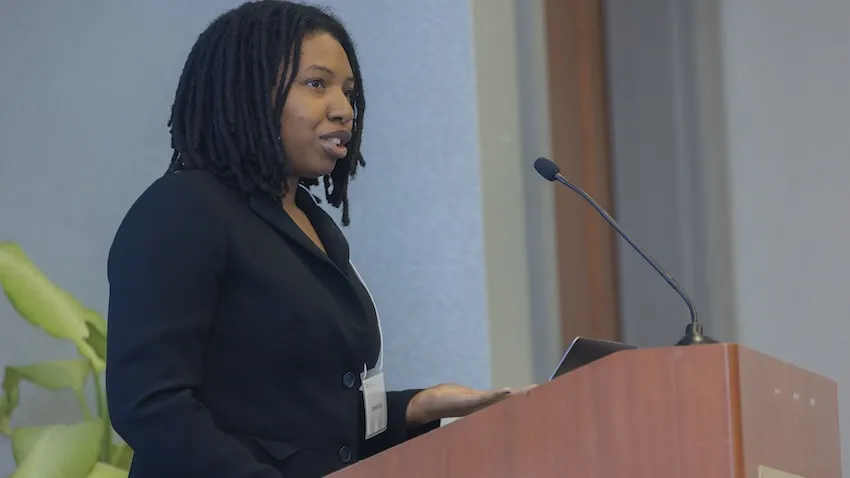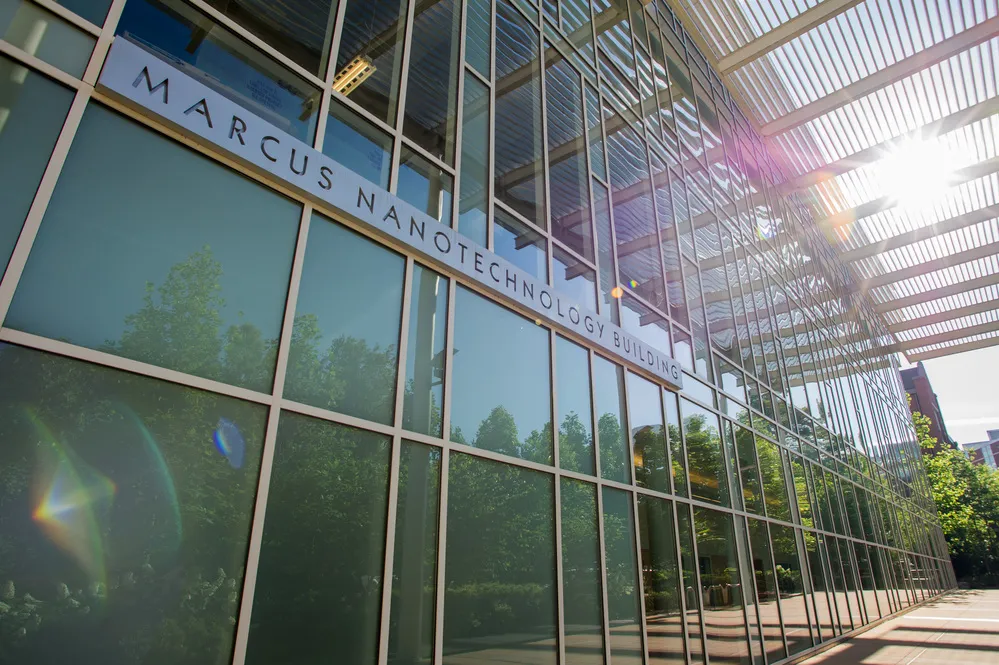Nov. 27, 2024
On Nov. 12, CREATE-X hosted a panel discussion featuring Y Combinator (YC) partner Brad Flora and Georgia Tech and Startup Launch alumni. In addition to sharing experiences, panelists offered practical advice and feedback for aspiring entrepreneurs, and attendees enjoyed the opportunity to network.
Y Combinator, which has produced companies like Twitch, Reddit, AirBnB, and Coinbase, has funded over 143 Georgia Tech alumni, surpassing institutions like the University of Michigan, Duke, and Princeton. YC recruits startups four times a year and provides a $500,000 investment.
Spotlight on Founders
Flora, the event's keynote speaker, shared his journey from a YC founder to a partner, emphasizing the accelerator's commitment to supporting college-age founders. He also spoke about finding ideas, meeting co-founders, knowing when to persist and when to pivot, and more.
“A lot of people think you have to have a great startup idea before you start working on a startup,” Flora said. “The theme you find again and again for the best YC founders is that they were doing something that was interesting to them.”
Flora encouraged students to explore their interests and identify problems they are passionate about solving. He also spoke about "tar pit ideas,” or ideas that seem interesting and novel but don’t translate to a wider audience and wouldn’t be widely used. He advised them to focus on ideas with clear, demonstrable demand.
“The best way to avoid tar pit ideas is to get feedback from your users and find out if they’re actually using them,” Flora said.
Georgia Tech alumni and Greptile founders SooHoon Choi and Vaishant Kameswaran talked about the origins of their company. Choi and Daksh Gupta, their other co-founder, participated in CREATE-X Capstone and then in CREATE-X Startup Launch to develop Tabnam, which initially was an AI shopping assistant that scraped the internet to tell users what people think about their product.
The founders discussed starting Tabnam in a course and moving across the country to work on it in their apartment to getting rejected by YC, pivoting the startup at a hackathon, and developing Greptile. This AI product enables large software teams to review core changes before merging, find issues in their code, understand the source of bugs, and perform other related tasks. That iteration proved successful, gaining millions in funding and hundreds of customers.
Gupta spoke about a framework that kept the co-founders open to pivots. “Startups aren’t small companies. They’re a hypothesis that asks if a company should exist in this space. That means your job is to prove or disprove that hypothesis,” he said.
For more insights, watch the video of the event.
Opportunities for Entrepreneurs
Students, faculty, researchers, and alumni interested in developing their own startups are encouraged to apply to CREATE-X's Startup Launch. The program provides $5,000 in optional seed funding, $150,000 in in-kind services, mentorship, entrepreneurial workshops, networking events, and resources to help build and scale startups. The program culminates in Demo Day, where teams present their startups to potential investors. The deadline to apply for Startup Launch is March 19, 2025. Spots are limited. Apply now for a higher chance of acceptance and early feedback.
News Contact
Breanna Durham
Marketing Strategist
Nov. 26, 2024
Josh Luber, co-founder of StockX, zerocool, Fanatics Collectibles, and ghostwrite, recently surprised Georgia Tech students with a guest appearance at CREATE-X’s Deep Startups workshop. The workshop, part of the Institute’s CREATE-X entrepreneurship program, features accomplished entrepreneurs who share real-world insights on launching and scaling successful ventures. The workshop sessions offer students a rare chance to learn directly from industry leaders.
Luber, best known for transforming his passion for sneakers into the billion-dollar marketplace StockX, has since become a serial entrepreneur. His ventures include collectibles, trading cards, and beyond, showcasing his ability to identify and capitalize on emerging markets.
During the recent workshop, Luber shared his candid experiences, including how he pivoted after a layoff, transitioned between corporate roles and entrepreneurship, raised capital during a market downturn, and created opportunities by "making his own luck." The 46-year-old entrepreneur provided valuable lessons on resilience, adaptability, and innovation in an ever-changing entrepreneurial landscape.
Watch the workshop video to hear insights from Luber.
Start Your Own Venture With CREATE-X Startup Launch
Georgia Tech students, faculty, alumni, and researchers interested in starting or developing their own startups are encouraged to apply for CREATE-X’s Startup Launch program. The program offers $5,000 in optional seed funding, $150,000 in in-kind services such as legal and accounting support, mentorship from seasoned entrepreneurs, and more. The next application deadline is March 19, 2025. Early applicants receive feedback and have a higher chance of acceptance. Apply now.
News Contact
Breanna Durham
Marketing Strategist
Nov. 22, 2024
The Department of Commerce has granted the Semiconductor Research Corporation (SRC), its partners, and Georgia Institute of Technology $285 million to establish and operate the 18th Manufacturing USA Institute. The Semiconductor Manufacturing and Advanced Reseach with Twins (SMART USA) will focus on using digital twins to accelerate the development and deployment of microelectronics. SMART USA, with more than 150 expected partner entities representing industry, academia, and the full spectrum of supply chain design and manufacturing, will span more than 30 states and have combined funding totaling $1 billion.
This is the first-of-its-kind CHIPS Manufacturing USA Institute.
“Georgia Tech’s role in the SMART USA Institute amplifies our trailblazing chip and advanced packaging research and leverages the strengths of our interdisciplinary research institutes,” said Tim Lieuwen, interim executive vice president for Research. “We believe innovation thrives where disciplines and sectors intersect. And the SMART USA Institute will help us ensure that the benefits of our semiconductor and advanced packaging discoveries extend beyond our labs, positively impacting the economy and quality of life in Georgia and across the United States.”
The 3D Systems Packaging Research Center (PRC), directed by School of Electrical and Computer Engineering Dan Fielder Professor Muhannad Bakir, played an integral role in developing the winning proposal. Georgia Tech will be designated as the Digital Innovation Semiconductor Center (DISC) for the Southeastern U.S.
“We are honored to collaborate with SRC and their team on this new Manufacturing USA Institute. Our partnership with SRC spans more than two decades, and we are thrilled to continue this collaboration by leveraging the Institute’s wide range of semiconductor and advanced packaging expertise,” said Bakir.
Through the Institute of Matter and Systems’ core facilities, housed in the Marcus Nanotechnology Building, DISC will accelerate semiconductor and advanced packaging development.
“The awarding of the Digital Twin Manufacturing USA Institute is a culmination of more than three years of work with the Semiconductor Research Corporation and other valued team members who share a similar vision of advancing U.S. leadership in semiconductors and advanced packaging,” said George White, senior director for strategic partnerships at Georgia Tech.
“As a founding member of the SMART USA Institute, Georgia Tech values this long-standing partnership. Its industry and academic partners, including the HBCU CHIPS Network, stand ready to make significant contributions to realize the goals and objectives of the SMART USA Institute,” White added.
Georgia Tech also plans to capitalize on the supply chain and optimization strengths of the No. 1-ranked H. Milton Stewart School of Industrial and Systems Engineering (ISyE). ISyE experts will help develop supply-chain digital twins to optimize and streamline manufacturing and operational efficiencies.
David Henshall, SRC vice president of Business Development, said, “The SMART USA Institute will advance American digital twin technology and apply it to the full semiconductor supply chain, enabling rapid process optimization, predictive maintenance, and agile responses to chips supply chain disruptions. These efforts will strengthen U.S. global competitiveness, ensuring our country reaps the rewards of American innovation at scale.”
News Contact
Amelia Neumeister | Research Communications Program Manager
Nov. 22, 2024
Georgia Tech is days away from the Fall 2024 Idea to Prototype (I2P) Showcase, set to take place on Dec. 3 at 5 p.m. in the Exhibition Hall. This event offers students a platform to present solutions built over the semester to tackle real-world problems and compete for rewards, including a golden ticket into the CREATE-X summer startup accelerator, Startup Launch. The program offers optional seed funding, workspace, entrepreneurial education, and continued mentorship to help students turn their prototypes into viable startups. Over 50 teams will present their prototypes at the showcase.
The event is open to all Georgia Tech students, faculty, staff, and the local community. Tickets are available now but are limited, so register for the I2P Showcase today.
Each semester, students in the Idea-to-Prototype course take time out of their schedules, similar to undergraduate research, to build prototypes. Teams accepted into I2P receive a reimbursement of up to $500 for physical expenses, course credit (undergraduate students only), and mentorship from a Georgia Tech faculty member.
During the showcase, participants and judges interact with the projects and give feedback. The criteria for judging are centered on innovation and overall market and impact potential. Judges can include industry professionals, faculty members, and alumni.
Throughout I2P Showcase history, many winning projects have gone on to achieve significant success. One is CaseDocker, which provides an end-to-end workflow management system. The startup now has a user base of over 400 global clients, including Fortune 500 companies. Other winners of the showcase include a blockchain-based music application, Radiochain, a personal financial management platform, Dolfin Solutions, and an EEG monitoring device for pediatric seizure detection, NeuroChamp.
This semester, the I2P cohort includes a digital twin using individual data and AI for health screenings and early detection, an active shooter detection and tracking tool, an AR tool that turns walls into interactive canvases, a device that detects overdosages, 3D-printed circuit boards, an AI detector for digital media, and more.
Whether you're a student with a passion for entrepreneurship, a faculty member interested in the latest student innovations, or a community member looking to support local talent, the I2P Showcase is a perfect opportunity to explore student innovations, mingle, and enjoy refreshments. Register for the I2P Showcase today and join us at the Exhibition Hall for an evening of creativity and community.
Students interested in participating in I2P can do so in the spring, summer, or fall semesters. The registration process involves providing a brief description of the project, the team members involved, and the current stage of development. The deadline for applications is Jan. 6 for Spring 2025 and May 12 for Summer 2025.
News Contact
Breanna Durham
Marketing Strategist
Nov. 21, 2024
In a significant step towards fostering international collaboration and advancing cutting-edge technologies in manufacturing, Georgia Tech recently signed Memorandums of Understanding (MoUs) with the Korea Institute of Industrial Technology (KITECH) and the Korea Automotive Technology Institute (KATECH). Facilitated by the Georgia Tech Manufacturing Institute (GTMI), this landmark event underscores Georgia Tech’s commitment to global partnerships and innovation in manufacturing and automotive technologies.
“This is a great fit for the institute, the state of Georgia, and the United States, enhancing international cooperation,” said Thomas Kurfess, GTMI executive director and Regents’ Professor in the George W. Woodruff School of Mechanical Engineering (ME). “An MoU like this really gives us an opportunity to bring together a larger team to tackle international problems.”
“An MoU signing between Georgia Tech and entities like KITECH and KATECH signifies a formal agreement to pursue shared goals and explore collaborative opportunities, including joint research projects, academic exchanges, and technological advancements,” said Seung-Kyum Choi, an associate professor in ME and a major contributor in facilitating both partnerships. “Partnering with these influential institutions positions Georgia Tech to expand its global footprint and enhance its impact, particularly in areas like AI-driven manufacturing and automotive technologies.”
The state of Georgia has seen significant growth in investments from Korean companies. Over the past decade, approximately 140 Korean companies have committed around $23 billion to various projects in Georgia, creating over 12,000 new jobs in 2023 alone. This influx of investment underscores the strong economic ties between Georgia and South Korea, further bolstered by partnerships like those with KITECH and KATECH.
“These partnerships not only provide access to new resources and advanced technologies,” says Choi, “but create opportunities for joint innovation, furthering GTMI’s mission to drive transformative breakthroughs in manufacturing on a global scale.”
The MoUs with KITECH and KATECH are expected to facilitate a wide range of collaborative activities, including joint research projects that leverage the strengths of both institutions, academic exchanges that enrich the educational experiences of students and faculty, and technological advancements that push the boundaries of current manufacturing and automotive technologies.
“My hopes for the future of Georgia Tech’s partnerships with KITECH and KATECH are centered on fostering long-term, impactful collaborations that drive innovation in manufacturing and automotive technologies,” Choi noted. “These partnerships do not just expand our reach; they solidify our leadership in shaping the future of manufacturing, keeping Georgia Tech at the forefront of industry breakthroughs worldwide.”
Georgia Tech has a history of successful collaborations with Korean companies, including a multidecade partnership with Hyundai. Recently, the Institute joined forces with the Korea Institute for Advancement of Technology (KIAT) to establish the KIAT-Georgia Tech Semiconductor Electronics Center to advance semiconductor research, fostering sustainable partnerships between Korean companies and Georgia Tech researchers.
“Partnering with KATECH and KITECH goes beyond just technological innovation,” said Kurfess, “it really enhances international cooperation, strengthens local industry, drives job creation, and boosts Georgia’s economy.”
News Contact
Audra Davidson
Research Communications Program Manager
Georgia Tech Manufacturing Institute
Nov. 21, 2024
Deven Desai and Mark Riedl have seen the signs for a while.
Two years since OpenAI introduced ChatGPT, dozens of lawsuits have been filed alleging technology companies have infringed copyright by using published works to train artificial intelligence (AI) models.
Academic AI research efforts could be significantly hindered if courts rule in the plaintiffs' favor.
Desai and Riedl are Georgia Tech researchers raising awareness about how these court rulings could force academic researchers to construct new AI models with limited training data. The two collaborated on a benchmark academic paper that examines the landscape of the ethical issues surrounding AI and copyright in industry and academic spaces.
“There are scenarios where courts may overreact to having a book corpus on your computer, and you didn’t pay for it,” Riedl said. “If you trained a model for an academic paper, as my students often do, that’s not a problem right now. The courts could deem training is not fair use. That would have huge implications for academia.
“We want academics to be free to do their research without fear of repercussions in the marketplace because they’re not competing in the marketplace,” Riedl said.
Desai is the Sue and John Stanton Professor of Business Law and Ethics at the Scheller College of Business. He researches how business interests and new technology shape privacy, intellectual property, and competition law. Riedl is a professor at the College of Computing’s School of Interactive Computing, researching human-centered AI, generative AI, explainable AI, and gaming AI.
Their paper, Between Copyright and Computer Science: The Law and Ethics of Generative AI, was published in the Northwestern Journal of Technology and Intellectual Property on Monday.
Desai and Riedl say they want to offer solutions that balance the interests of various stakeholders. But that requires compromise from all sides.
Researchers should accept they may have to pay for the data they use to train AI models. Content creators, on the other hand, should receive compensation, but they may need to accept less money to ensure data remains affordable for academic researchers to acquire.
Who Benefits?
The doctrine of fair use is at the center of every copyright debate. According to the U.S. Copyright Office, fair use permits the unlicensed use of copyright-protected works in certain circumstances, such as distributing information for the public good, including teaching and research.
Fair use is often challenged when one or more parties profit from published works without compensating the authors.
Any original published content, including a personal website on the internet, is protected by copyright. However, copyrighted material is republished on websites or posted on social media innumerable times every day without the consent of the original authors.
In most cases, it’s unlikely copyright violators gained financially from their infringement.
But Desai said business-to-business cases are different. The New York Times is one of many daily newspapers and media companies that have sued OpenAI for using its content as training data. Microsoft is also a defendant in The New York Times’ suit because it invested billions of dollars into OpenAI’s development of AI tools like ChatGPT.
“You can take a copyrighted photo and put it in your Twitter post or whatever you want,” Desai said. “That’s probably annoying to the owner. Economically, they probably wanted to be paid. But that’s not business to business. What’s happening with Open AI and The New York Times is business to business. That’s big money.”
OpenAI started as a nonprofit dedicated to the safe development of artificial general intelligence (AGI) — AI that, in theory, can rival human thinking and possess autonomy.
These AI models would require massive amounts of data and expensive supercomputers to process that data. OpenAI could not raise enough money to afford such resources, so it created a for-profit arm controlled by its parent nonprofit.
Desai, Riedl, and many others argue that OpenAI ceased its research mission for the public good and began developing consumer products.
“If you’re doing basic research that you’re not releasing to the world, it doesn’t matter if every so often it plagiarizes The New York Times,” Riedl said. “No one is economically benefitting from that. When they became a for-profit and produced a product, now they were making money from plagiarized text.”
OpenAI’s for-profit arm is valued at $80 billion, but content creators have not received a dime since the company has scraped massive amounts of copyrighted material as training data.
The New York Times has posted warnings on its sites that its content cannot be used to train AI models. Many other websites offer a robot.txt file that contains instructions for bots about which pages can and cannot be accessed.
Neither of these measures are legally binding and are often ignored.
Solutions
Desai and Riedl offer a few options for companies to show good faith in rectifying the situation.
- Spend the money. Desai says Open AI and Microsoft could have afforded its training data and avoided the hassle of legal consequences.
“If you do the math on the costs to buy the books and copy them, they could have paid for them,” he said. “It would’ve been a multi-million dollar investment, but they’re a multi-billion dollar company.”
- Be selective. Models can be trained on randomly selected texts from published works, allowing the model to understand the writing style without plagiarizing.
“I don’t need the entire text of War and Peace,” Desai said. “To capture the way authors express themselves, I might only need a hundred pages. I’ve also reduced the chance that my model will cough up entire texts.”
- Leverage libraries. The authors agree libraries could serve as an ideal middle ground as a place to store published works and compensate authors for access to those works, though the amount may be less than desired.
“Most of the objections you could raise are taken care of,” Desai said. “They are legitimate access copies that are secure. You get access to only as much as you need. Libraries at universities have already become schools of information.”
Desai and Riedl hope the legal action taken by publications like The New York Times will send a message to companies that develop AI tools to pump the breaks. If they don’t, researchers uninterested in profit could pay the steepest price.
The authors say it’s not a new problem but is reaching a boiling point.
“In the history of copyright, there are ways that society has dealt with the problem of compensating creators and technology that copies or reduces your ability to extract money from your creation,” Desai said. “We wanted to point out there’s a way to get there.”
News Contact
Nathan Deen
Communications Officer
School of Interactive Computing
Nov. 21, 2024
Martin Luther Hubbard is Vice President of Supply Chain Operations at The Coca-Cola Company. Martin is an accomplished Business Leader with over 25 years of progressive leadership roles in Supply Chain Operations, International Logistics Management and Financial Controllership. He has broad and comprehensive experiences supporting Fortune 200 companies in the Consumer Products Goods and Automotive Industries and is known as a transformational leader.
During his 20-year career at The Coca-Cola Company, Martin assumed several roles with increased responsibilities in Houston and Atlanta. In his current role as Vice President, Supply Chain Operations, he leads a team that focuses on delivering our innovation initiatives, driving strategic supply chain solutions, and delivering multi-year Design-to-Value/Sustainability savings.
Martin began his career at the Eaton Corporation in Atlanta, GA where he held several positions including, Plant Financial Controller, Plant Manager, and finally Global Supply Chain Lead. In those roles, he was able to improve manufacturing output, employee engagement and financial performance for the facility he managed.
Martin also provides supply chain and finance consulting as a board member for local non-profit organizations.
Martin is a native of Atlanta, GA. He obtained his bachelor’s degree in Accounting | Finance from Georgia State University and his Master’s Degree in International Business from Mercer University (GA). He is also a practicing CPA in the State of Georgia.
SCL appreciates Mr. Hubbard's participation in our Industry Advisory Board and his willingness to lend his expertise to help shape our strategic initiatives into 2025.
Nov. 18, 2024
Margaret E. Kosal leads the "Investigating the Future of Metamaterials for National Security and To Avoid Technological Surprise" research initiative for the Institute for Matter and Systems at Georgia Tech. In this role, her research focuses on investigating technical aspects of cutting-edge metamaterials design, synthesis, and development to understand the potential impacts of this type of emerging technology on national security and geopolitics. Kosal is also a professor in the Sam Nunn School of International Affairs.
In this brief Q&A, Kosal discusses her research focus, how it relates to Matter and System’s core research focuses, and the national impact of this initiative.
What is your field of expertise and at what point in your life did you first become interested in this area?
My formal education and background are in the physical sciences (PhD Chemistry); my scholarship, research, teaching, external engagement, and impact are intrinsically interdisciplinary; and I have found a scholarly home and community in the international relations discipline, primarily working in the areas of security and science and technology (S&T) policy.
What questions or challenges sparked your current research?
With one of my PhD students, I’d previously done research on potential disruptive potential of metamaterials, finding them to potentially be a potentially revolutionary innovation to the power of global and regional hegemons. That work found that revisionist actors, primarily non-state actors, likely will benefit disproportionately from acquiring a metamaterial adaptive camouflage (MMAC) capability but will struggle to do so due to the technical challenge of advanced R&D, particularly in the near and mid-term. The implication found was that status quo powers – who are likely to be the first to develop a viable capability – must emphasize parallel development of countermeasures and limit the negative potential of the technology’s proliferation. With this project, I want to dive deeper into the technical aspects of cutting-edge metamaterials design, synthesis, and development to understand the potential impacts of this type of emerging technology on national security and geopolitics.
Matter and systems refer to the transformational technological and societal systems that arise from the convergence of innovative materials, devices, and processes. Why is your initiative important to the development of the IMS research strategy?
In November 2016, US Army Lieutenant General HR McMaster, then-Deputy Commanding General for Army Futures and Director of the Army Capability Integration Center (ARCIC) invoked the concept of invisible tanks at meeting on Ground Combat Platforms at the Institute of Land Warfare. I was speaking at the same meeting and commented in my remarks on the need for new capabilities that shift the approach to survivability from protection via mass (which is limiting) to capabilities for active defense and adaptive responses such as via meta-materials.
Over the last century, the dominant mechanism to achieve parity or asymmetric advantages in land warfare (e.g., maneuver warfare using tanks and other vehicles) has relied on armor and other materials that more effectively absorb kinetic impacts. In the mid-20th Century, the US Air Force shifted to relying on speed and stealth for asymmetric advantage. New conceptual approaches are needed and will have significant implications for conflict, cooperation, and the nature of land warfare. In the case of land warfare (as with air power), materials and systems are fundamental to being able to achieve those asymmetric advantages. The convergence of these innovative materials into existing and new capabilities (vehicles) is likely to result in revolutionary changes to societal systems.
What are the broader global and social benefits of the research you and your team conduct?
My scholarship significantly contributes to a better and more nuanced understanding of the relationships among science, technology, and security, emphasizing the complex interactions among science, technology, geopolitics, knowledge, innovation, governance (laws and treaties), diplomacy, and institutions. My work explains how these phenomena intersect and impact geopolitics by developing and testing novel analytical frameworks.
What are your plans for engaging a wider Georgia Tech faculty pool with the Institute for Matter and Systems research?
I’m going to be reaching out directly to GT faculty and GTRI researchers in Engineering and the Sciences. I am also interested in exploring how my research integrates and might further other IMS Research Initiatives (e.g. “Mechanical Metamaterials” (Rocklin/PHYS) and Research Centers (e.g., the Center for Organic Photonics and Electronics).
Nov. 15, 2024
The Automatic Speech Recognition (ASR) models that power voice assistants like Amazon Alexa may have difficulty transcribing English speakers with minority dialects.
A study by Georgia Tech and Stanford researchers compared the transcribing performance of leading ASR models for people using Standard American English (SAE) and three minority dialects — African American Vernacular English (AAVE), Spanglish, and Chicano English.
Interactive Computing Ph.D. student Camille Harris is the lead author of a paper accepted into the 2024 Conference on Empirical Methods in Natural Language Processing (EMNLP) this week in Miami.
Harris recruited people who spoke each dialect and had them read from a Spotify podcast dataset, which includes podcast audio and metadata. Harris then used three ASR models — wav2vec 2.0, HUBERT, and Whisper — to transcribe the audio and compare their performances.
For each model, Harris found SAE transcription significantly outperformed each minority dialect. The models more accurately transcribed men who spoke SAE than women who spoke SAE. Members who spoke Spanglish and Chicano English had the least accurate transcriptions out of the test groups.
While the models transcribed SAE-speaking women less accurately than their male counterparts, that did not hold true across minority dialects. Minority men had the most inaccurate transcriptions of all demographics in the study.
“I think people would expect if women generally perform worse and minority dialects perform worse, then the combination of the two must also perform worse,” Harris said. “That’s not what we observed.
“Sometimes minority dialect women performed better than Standard American English. We found a consistent pattern that men of color, particularly Black and Latino men, could be at the highest risk for these performance errors.”
Addressing underrepresentation
Harris said the cause of that outcome starts with the training data used to build these models. Model performance reflected the underrepresentation of minority dialects in the data sets.
AAVE performed best under the Whisper model, which Harris said had the most inclusive training data of minority dialects.
Harris also looked at whether her findings mirrored existing systems of oppression. Black men have high incarceration rates and are one of the people groups most targeted by police. Harris said there could be a correlation between that and the low rate of Black men enrolled in universities, which leads to less representation in technology spaces.
“Minority men performing worse than minority women doesn’t necessarily mean minority men are more oppressed,” she said. “They may be less represented than minority women in computing and the professional sector that develops these AI systems.”
Harris also had to be cautious of a few variables among AAVE, including code-switching and various regional subdialects.
Harris noted in her study there were cases of code-switching to SAE. Speakers who code-switched performed better than speakers who did not.
Harris also tried to include different regional speakers.
“It’s interesting from a linguistic and history perspective if you look at migration patterns of Black folks — perhaps people moving from a southern state to a northern state over time creates different linguistic variations,” she said. “There are also generational variations in that older Black Americans may speak differently from younger folks. I think the variation was well represented in our data. We wanted to be sure to include that for robustness.”
TikTok barriers
Harris said she built her study on a paper she authored that examined user-design barriers and biases faced by Black content creators on TikTok. She presented that paper at the Association of Computing Machinery’s (ACM) 2023 Conference on Computer Supported Cooperative Works.
Those content creators depended on TikTok for a significant portion of their income. When providing captions for videos grew in popularity, those creators noticed the ASR tool built into the app inaccurately transcribed them. That forced the creators to manually input their captions, while SAE speakers could use the ASR feature to their benefit.
“Minority users of these technologies will have to be more aware and keep in mind that they’ll probably have to do a lot more customization because things won’t be tailored to them,” Harris said.
Harris said there are ways that designers of ASR tools could work toward being more inclusive of minority dialects, but cultural challenges could arise.
“It could be difficult to collect more minority speech data, and you have to consider consent with that,” she said. “Developers need to be more community-engaged to think about the implications of their models and whether it’s something the community would find helpful.”
News Contact
Nathan Deen
Communications Officer
School of Interactive Computing
Nov. 15, 2024
The Institute for Matter and Systems (IMS) at Georgia Tech has announced the fall 2024 core facility seed grant recipients. The primary purpose of this program is to give graduate students in diverse disciplines working on original and unfunded research in micro- and nanoscale projects the opportunity to access the most advanced academic cleanroom space in the Southeast. In addition to accessing the labs' high-level fabrication, lithography, and characterization tools, the awardees will have the opportunity to gain proficiency in cleanroom and tool methodology and access the consultation services provided by research staff members in IMS. Seed Grant awardees are also provided travel support to present their research at a scientific conference.
In addition to student research skill development, this biannual grant program gives faculty with novel research topics the ability to develop preliminary data to pursue follow-up funding sources. The Core Facility Seed Grant program is supported in part by the Southeastern Nanotechnology Infrastructure Corridor (SENIC), a member of the National Science Foundation’s National Nanotechnology Coordinated Infrastructure (NNCI).
The five winning projects in this round were awarded IMS cleanroom and lab access time to be used over the next year.
The Fall 2024 IMS Core Facility Seed Grant recipients are:
Manufacturing of a Diamagnetically Enhanced PEM Electrolysis Cell
PI: Alvaro Romero-Calvo
Student: Shay Vitale
Daniel Guggenheim School of Aerospace Engineering
Biomimicking Organ-On-a-Chip Models
PI: Nick Housley
Student: Aref Valipour
School of Biological Sciences
Single-shot LWIR Hyperspectral Imaging Using Meta-optics
PI: Shu Jia
Student: Jooyeong Yun (School of Electrical and Computer Engineering)
The Wallace H. Coulter Department of Biomedical Engineering
Large-area Three-dimensional Nanolithography Using Two-photon Polymerization
PI: Sourabh Saha
Student: Golnaz Aminaltojjari
George W. Woodruff School of Mechanical Engineering
Effects of Geochemical Constraints on the Redistribution of Rare Earth Elements (REE) during Chemical Weathering
PI: Yuanzhi Tang
Student: Hang Xu
School of Earth and Atmospheric Sciences
